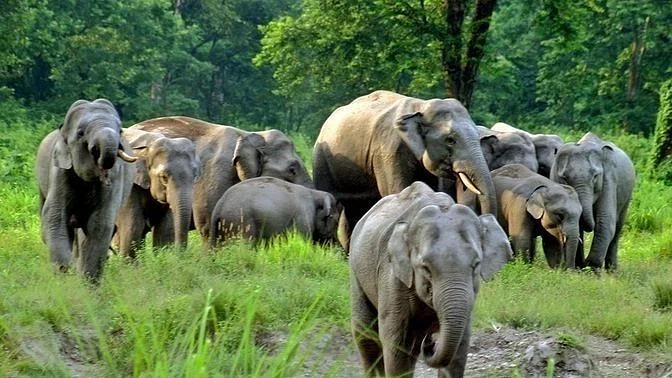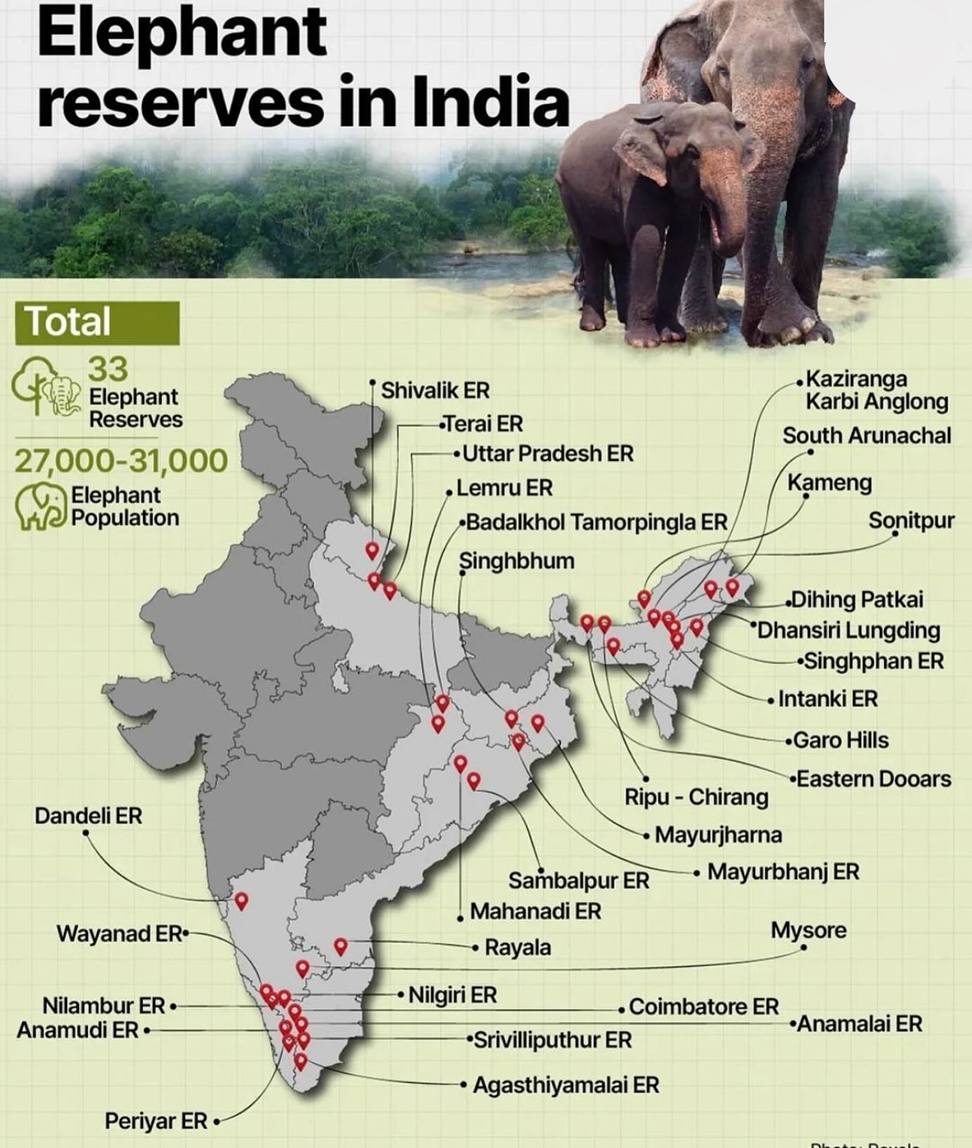Context: The Indian elephant population has experienced a concerning decline, as highlighted in the unreleased Environment Ministry’s elephant census report — Status of Elephant in India 2022-23.
Status of Elephant in India 2022-23 is an unreleased report, authored by seven scientists and officials from the Dehradun-based WII and its nodal ministry in New Delhi, provides India's first-ever "scientific" estimate of the elephant population, offering valuable insights for conservation efforts.
· The report indicates a 20% decrease in the overall elephant population since 2017, with some regions, particularly in Central India and the Eastern Ghats, witnessing alarming reductions of up to 41%.
Key Findings from the Report:
- Population Decline:
- The census reveals that specific regions have seen a drastic drop in the elephant population. For instance, Southern West Bengal, Jharkhand, and Odisha reported losses of 84%, 68%, and 54%, respectively. The report estimates that nearly 1,700 elephants have been lost in these areas, while a smaller number may have migrated to adjacent states like Chhattisgarh, Madhya Pradesh, and Andhra Pradesh.
- Western Ghats:
- The Western Ghats are not exempt from this decline, showing a potential 18% drop in elephant numbers, particularly in Kerala, where the population decreased by 2,900 elephants, equating to 51% ofits previous count.
- Northeast Region:
- The report's figures for the northeastern states are extrapolated from previous data (2017), as the new modeling could not be completed due to limited primary data and training. The Northeast accounted for approximately one-third of India’s total elephant population, which was estimated at 29,964 in 2017.
- Factors Contributing to Decline:
- The report attributes the population decline to several factors, notably the increase in developmental projects, including unregulated mining and linear infrastructure projects, which fragment habitats and increase human-elephant conflicts. Poaching, railway accidents, and electrocution are additional threats to the elephants.
- Conservation Recommendations:
- The report urges strategies aimed at strengthening elephant corridors, restoring habitats, and ensuring community support for elephant conservation efforts. It emphasizes the need for comprehensive assessments in the Northeast to devise targeted conservation actions.
Challenges in the Northeast:
The situation for elephants in the Northeast is particularly precarious due to fragmented populations caused by urban development, mining, agriculture, and other human activities. These factors have made the movement of elephants both difficult and dangerous. A recent report highlights the need for focused population estimates in the region to better understand the situation and devise effective conservation strategies.
Wildlife researchers stress that the conditions for elephants in the Northeast are dire. Much of the habitat is dominated by human settlements, tea plantations, and infrastructure that threaten the species. Outside a few protected areas, elephants face significant challenges that could lead to further declines in their population.
Elephants in India:
· Leading States in Elephant population: The states with the highest elephant populations are Karnataka, followed by Assam and Kerala. Karnataka alone has a substantial number of elephants, which highlights its role as a critical habitat for this species
· Conservation Status: Elephants are listed as Endangered on the IUCN Red List, and they are protected under several international conventions, including CITES Appendix I and the Wildlife Protection Act of 1972 in India, where they are listed in Schedule I.
Threats to Elephants:
1. Habitat Loss: The habitat of elephants is rapidly diminishing due to human population growth. Many wild elephant populations are now small and isolated, unable to coexist as traditional migration routes have been obstructed by human settlements.
2. Fragmentation: Previously continuous habitats for elephants have been fragmented into smaller sections. Large construction projects—such as dams, roads, and industrial complexes—along with plantations and expanding human settlements, have further disrupted their living spaces.
3. Unlawful Killing: As elephant incursions into farms and villages become more frequent, conflicts arise, leading to the loss of human lives and property. In retaliation, local communities often kill elephants. Although the capture of elephants is prohibited in countries like India, Vietnam, and Myanmar to protect their natural herds, illegal killings continue, especially for the wildlife trade.
4. Poaching: Poaching remains a significant threat, particularly targeting male elephants, which possess tusks. This selective removal can lead to a rise in the proportion of tuskless males in the population, impacting genetic diversity.
Measures for the conservation of elephants and their habitat
· Financial and Technical Assistance: Under the Centrally Sponsored Scheme for Project Tiger and Elephant, the Ministry provides support to states/UTs for elephant protection, habitat conservation, and addressing human-elephant conflicts.
· Integrated Development of Wildlife Habitat: This scheme improves natural habitats for elephants by enhancing water sources, planting fodder trees, and regenerating bamboo.
· Compensatory Afforestation Fund Act, 2016: Funds can be used for wildlife habitat development, including elephant rescue centres.
· Human-Wildlife Conflict Advisory: Issued in February 2021, this advisory recommends coordinated actions, identification of conflict hotspots, and establishment of rapid response teams to manage human-wildlife conflicts.
· Elephant Corridors: Ground validation of 150 elephant corridors across 15 states has been conducted to protect these critical migration routes.
· Elephant Reserves: A total of 33 Elephant Reserves have been established in 14 major states to focus conservation efforts and reduce conflicts.
· Wildlife (Protection) Act, 1972: Provides regulatory functions to manage human-wildlife conflicts.
· Collaboration with Railways and Power Departments: Joint advisories and meetings have been held to mitigate risks from railways and power infrastructure, including compensation enhancements for wildlife depredation.
· The Captive Elephant (Transfer or Transport) Rules, 2024, notified on March 14 after Parliament amended the Wildlife Protection Act, allows the transfer of elephants for “religious or any other purpose” by those possessing valid ownership certificates.
· The elephant census, conducted every five years by the Wildlife Institute of India (WII), an autonomous body under the Ministry of Environment, is a key effort in tracking the country's elephant population.
Conclusion:
The elephant holds a pivotal place in Indian culture, deeply intertwined with the nation’s religious and historical legacy. Revered for centuries, these majestic creatures are an integral part of India’s identity, and it is impossible to imagine the country without them.
Conservation initiatives have been crucial in protecting India’s wild elephants, and while challenges persist, these efforts have begun to yield positive results. However, further safeguarding requires a stronger legal framework. Such recognition would not only enhance ecological balance but also improve the health of ecosystems.
|
Probable questions for UPSC mains examination: Study the impact of human-elephant conflicts in the Northeast region of India and suggest measures to mitigate these conflicts. |








